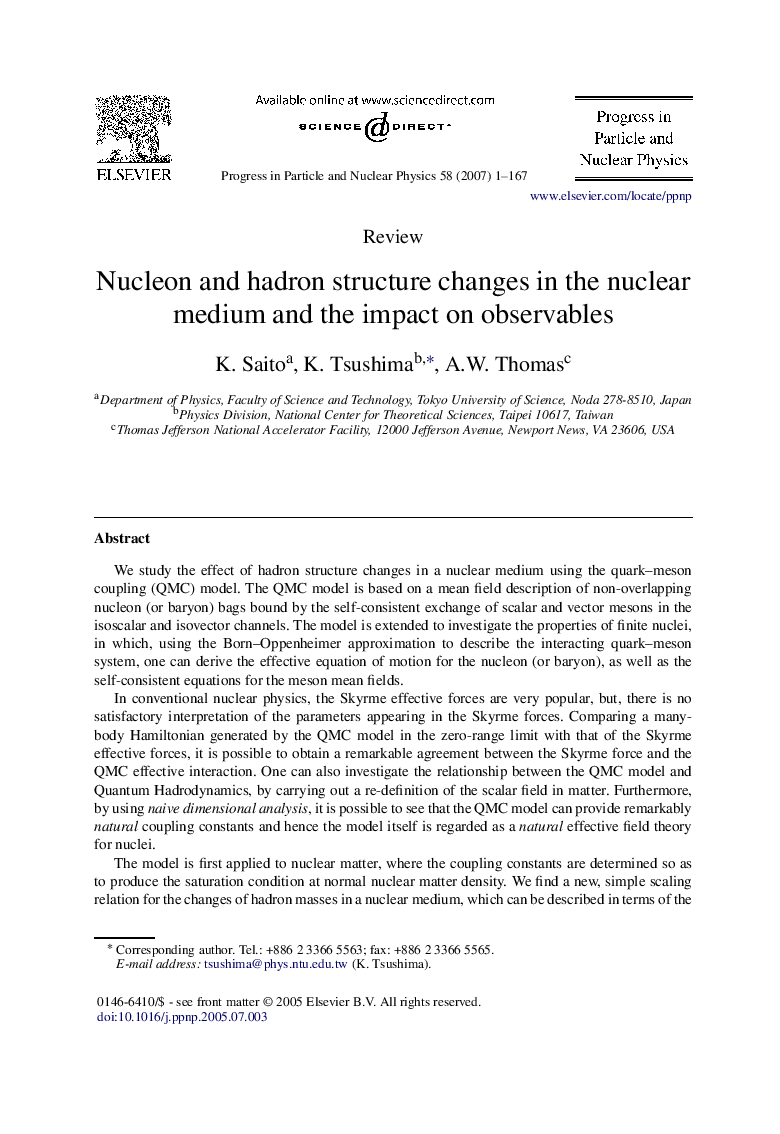| کد مقاله | کد نشریه | سال انتشار | مقاله انگلیسی | نسخه تمام متن |
|---|---|---|---|---|
| 1856814 | 1036254 | 2007 | 167 صفحه PDF | دانلود رایگان |

We study the effect of hadron structure changes in a nuclear medium using the quark–meson coupling (QMC) model. The QMC model is based on a mean field description of non-overlapping nucleon (or baryon) bags bound by the self-consistent exchange of scalar and vector mesons in the isoscalar and isovector channels. The model is extended to investigate the properties of finite nuclei, in which, using the Born–Oppenheimer approximation to describe the interacting quark–meson system, one can derive the effective equation of motion for the nucleon (or baryon), as well as the self-consistent equations for the meson mean fields.In conventional nuclear physics, the Skyrme effective forces are very popular, but, there is no satisfactory interpretation of the parameters appearing in the Skyrme forces. Comparing a many-body Hamiltonian generated by the QMC model in the zero-range limit with that of the Skyrme effective forces, it is possible to obtain a remarkable agreement between the Skyrme force and the QMC effective interaction. One can also investigate the relationship between the QMC model and Quantum Hadrodynamics, by carrying out a re-definition of the scalar field in matter. Furthermore, by using naive dimensional analysis, it is possible to see that the QMC model can provide remarkably natural coupling constants and hence the model itself is regarded as a natural effective field theory for nuclei.The model is first applied to nuclear matter, where the coupling constants are determined so as to produce the saturation condition at normal nuclear matter density. We find a new, simple scaling relation for the changes of hadron masses in a nuclear medium, which can be described in terms of the number of light quarks in a hadron and the value of the scalar mean field in matter. Once the coupling constants are fixed, the model can be applied to various finite nuclei, including strange and exotic hypernuclei. In this article, we discuss in detail the properties of hypernuclei and meson–nucleus deeply bound states.It is also of great interest that the QMC model predicts a variation of the nucleon form factors in nuclear matter, which will certainly affect the analysis of electron scattering off nuclei, including polarization transfer experiments. Recent experimental analysis of data taken at Jefferson Laboratory (JLab) and MAMI does indeed seem to support such a variation of nucleon form factors in nuclei. The change of nucleon structure in a nuclear medium is also expected to modify nuclear structure functions (the nuclear EMC effect), which are measured by scattering with high energy charged leptons and/or neutrinos. We study such possibilities, including consideration of the empirically observed, Bloom–Gilman (quark–hadron) duality.We also study hadronic reactions in a nuclear medium, namely, subthreshold kaon production in heavy ion collisions, DD and D¯ meson production in antiproton–nucleus collisions, and J/ΨJ/Ψ suppression. In particular, the modification of the DD and D¯ meson properties in a nuclear medium derived from the QMC model can lead to a large J/ΨJ/Ψ absorption cross section, which is required to explain the observed J/ΨJ/Ψ suppression in the microscopic hadronic comover dissociation scenario, without assuming the formation of a QGP phase.The present investigation indicates that the traditional nuclear/hadronic physics approach may have its limitations. It further suggests the need for the study of alternative approaches which include subhadronic degrees of freedom, even at normal nuclear matter density.
Journal: Progress in Particle and Nuclear Physics - Volume 58, Issue 1, January 2007, Pages 1–167